Image editing
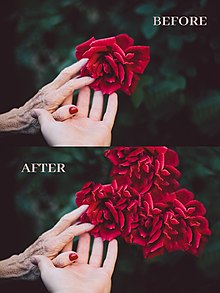
Image editingencompasses the processes of alteringimages,whether they aredigital photographs,traditionalphoto-chemical photographs,orillustrations.Traditional analog image editing is known asphoto retouching,using tools such as anairbrushto modify photographs or edit illustrations with any traditionalart medium.Graphic softwareprograms, which can be broadly grouped intovector graphics editors,raster graphics editors,and3D modelers,are the primary tools with which a user may manipulate, enhance, and transform images. Many image editing programs are also used torenderor createcomputer artfrom scratch. The term "image editing" usually refers only to the editing of 2D images, not 3D ones.
Basics of image editing
Rasterimages are stored on a computer in the form of a grid of picture elements, orpixels.These pixels contain the image's color and brightness information. Image editors can change the pixels to enhance the image in many ways. The pixels can be changed as a group or individually by the sophisticatedalgorithmswithin the image editors. This article mostly refers tobitmapgraphics editors, which are often used to alter photographs and other raster graphics. However,vector graphicssoftware, such asAdobe Illustrator,CorelDRAW,Xara Designer ProorInkscape,is used to create and modify vector images, which are stored as descriptions oflines,Bézier curves,andtextinstead of pixels. It is easier torasterizea vector image than tovectorizea raster image; how to go about vectorizing a raster image is the focus of much research in the field ofcomputer vision.Vector images can be modified more easily because they contain descriptions of the shapes for easy rearrangement. They are also scalable, being rasterizable at anyresolution.
Automatic image enhancement
Camera or computer image editing programs often offer basic automatic image enhancement features that correct colorhueand brightness imbalances as well as other image editing features, such asred eyeremoval,sharpnessadjustments,zoomfeatures and automaticcropping.These are called automatic because generally they happen without user interaction or are offered with one click of a button or mouse button or by selecting an option from a menu. Additionally, some automatic editing features offer a combination of editing actions with little or no user interaction.[citation needed]
Super-resolution imaging
Digital data compression
Many image file formats usedata compressionto reduce file size and save storage space. Digital compression of images may take place in the camera, or can be done on the computer with the image editor. When images are stored inJPEGformat, compression has already taken place. Both cameras andcomputer programsallow the user to set the level of compression.
Some compression algorithms, such as those used inPNGfile format, arelossless,which means no information is lost when the file is saved. By contrast, the more popularJPEGfile format uses alossycompression algorithm (based ondiscrete cosine transformcoding) by which the greater the compression, the more information is lost, ultimately reducing image quality or detail that can not be restored. JPEG uses knowledge of the way the human visual system perceives color to make this loss of detail less noticeable.
Image editor features
Listed below are some of the most used capabilities of the better graphics manipulation programs. The list is by no means all-inclusive. There are a myriad of choices associated with the application of most of these features.
Selection
One of the prerequisites for many of the applications mentioned below is a method ofselectingpart(s) of an image, thus applying a change selectively without affecting the entire picture. Most graphics programs have several means of accomplishing this, such as:
- a marquee tool for selecting rectangular or other regular polygon-shaped regions,
- alasso toolfor freehand selection of a region,
- amagic wand toolthat selects objects orregionsin the image defined by proximity of color orluminance,
- vector-based pen tools,
as well as more advanced facilities such asedge detection,masking,Alpha compositing,and color and channel-based extraction. The border of a selected area in an image is often animated with themarching antseffect to help the user to distinguish the selection border from the image background.
Layers


Another feature common to many graphics applications is that ofLayers,which are analogous to sheets of transparentacetate(each containing separate elements that make up a combined picture), stacked on top of each other, each capable of being individually positioned, altered, andblendedwith the layers below, without affecting any of the elements on the other layers. This is a fundamental workflow that has become the norm for the majority of programs on the market today, and enables maximum flexibility for the user while maintainingnon-destructive editingprinciples and ease of use.
Image size alteration
Image editors can resize images in a process often calledimage scaling,making them larger, or smaller. Highimage resolutioncameras can produce large images, which are often reduced in size forInternetuse. Image editor programs use a mathematical process calledresamplingto calculate new pixel values whose spacing is larger or smaller than the original pixel values. Images for Internet use are kept small, say 640 x 480 pixels, which would equal 0.3megapixels.
Cropping an image
Digital editors are used tocrop images.Cropping creates a new image by selecting a desired rectangular portion from the image being cropped. The unwanted part of the image is discarded. Image cropping does not reduce the resolution of the area cropped. Best results are obtained when the original image has a high resolution. A primary reason for cropping is to improve the image composition in the new image.
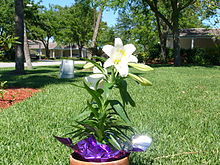 |
 |
Cutting out a part of an image from the background
Using a selection tool, the outline of the figure or element in the picture is traced/selected, and then the background is removed. Depending on how intricate the "edge" is this may be more or less difficult to do cleanly. For example, individual hairs can require a lot of work. Hence the use of the "green screen" technique (chroma key) which allows one to easily remove the background.
Histogram
Image editors have provisions to create animage histogramof the image being edited. The histogram plots the number of pixels in the image (vertical axis) with a particular brightness value (horizontal axis). Algorithms in the digital editor allow the user to visually adjust the brightness value of each pixel and to dynamically display the results as adjustments are made. Improvements in picture brightness and contrast can thus be obtained.[6]
 |
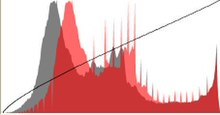 |
Noise reduction
Image editors may feature a number of algorithms which can add or removenoisein an image. SomeJPEGartifacts can be removed; dust and scratches can be removed and an image can be de-speckled. Noise reduction merely estimates the state of the scene without the noise and is not a substitute for obtaining a "cleaner" image. Excessive noise reduction leads to a loss of detail, and its application is hence subject to a trade-off between the undesirability of the noise itself and that of the reduction artifacts.
Noise tends to invade images when pictures are taken in low light settings. A new picture can be given an 'antiqued' effect by adding uniform monochrome noise.
Removal of unwanted elements
Most image editors can be used to remove unwanted branches, etc., using a "clone" tool. Removing these distracting elements draws focus to the subject, improving overallcomposition.
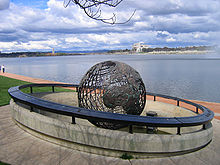 |
 |
Selective color change
Some image editors have color swapping abilities to selectively change the color of specific items in an image, given that the selected items are within a specific color range.

Image orientation
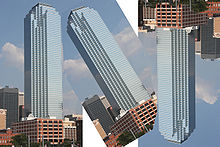
Image editors are capable of altering an image to be rotated in any direction and to any degree.Mirror imagescan be created and images can be horizontallyflippedor verticallyflopped.A small rotation of severaldegreesis often enough to level thehorizon,correctverticality(of a building, for example), or both. Rotated images usually requirecroppingafterwards, in order to remove the resulting gaps at the image edges.
Perspective control and distortion

Some image editors allow the user todistort(or "transform" ) the shape of an image. While this might also be useful for special effects, it is the preferred method of correcting the typicalperspectivedistortion that results from photographs being taken at anoblique angleto arectilinearsubject. Care is needed while performing this task, as the image is reprocessed usinginterpolationof adjacent pixels, which may reduce overall imagedefinition.The effect mimics the use of aperspective control lens,which achieves a similar correctionin-camerawithout loss of definition.
Lens correction
Photo manipulation packages have functions to correct images for various lensdistortions,including pincushion,fisheye,and barrel distortions. The corrections are in most cases subtle, but can improve the appearance of some photographs.
Enhancing images
Incomputer graphics,the enhancement of an image is the process of improving the quality of a digitally stored image by manipulating the image with software. It is quite easy, for example, to make an image lighter or darker, or to increase or decrease contrast. Advanced photo enhancement software also supports many filters for altering images in various ways.[7]Programs specialized for image enhancement are sometimes called image editors.
Sharpening and softening images
Graphics programs can be used to both sharpen and blur images in a number of ways, such asunsharp maskingordeconvolution.[8]Portraits often appear more pleasing when selectively softened (particularly the skin and the background) to better make the subject stand out.[citation needed]This can be achieved with a camera by using a largeaperture,or in the image editor by making a selection and then blurring it.Edge enhancementis an extremely common technique used to make images appear sharper, although purists frown on the result as appearing unnatural.

Another form of image sharpening involves a form of contrast. This is done by finding the average color of the pixels around each pixel in a specified radius, and then contrasting that pixel from that average color. This effect makes the image seem clearer, seemingly adding details. An example of this effect can be seen to the right. It is widely used in the printing and photographic industries for increasing the local contrasts and sharpening the images.
Selecting and merging of images

Many graphics applications are capable of merging one or more individual images into a single file. The orientation and placement of each image can be controlled.
When selecting a raster image that is not rectangular, it requires separating the edges from the background, also known as silhouetting. This is the digital-analog of cutting out the image from a physical picture.Clipping pathsmay be used to add silhouetted images to vector graphics or page layout files that retain vector data.Alpha compositing,allows for softtranslucentedges when selecting images. There are a number of ways to silhouette an image with soft edges, including selecting the image or its background by sampling similar colors, selecting the edges by raster tracing, or converting a clipping path to a raster selection. Once the image is selected, it may be copied and pasted into another section of the same file, or into a separate file. The selection may also be saved in what is known as anAlpha channel.
A popular way to create a composite image is to use transparentlayers.The background image is used as the bottom layer, and the image with parts to be added are placed in a layer above that. Using an imagelayer mask,all but the parts to be merged is hidden from the layer, giving the impression that these parts have been added to the background layer. Performing a merge in this manner preserves all of thepixel dataon both layers to more easily enable future changes in the new merged image.
Slicing of images
A more recent tool in digital image editing software is the image slicer. Parts of images for graphical user interfaces or web pages are easily sliced, labeled and saved separately from whole images so the parts can be handled individually by the display medium. This is useful to allow dynamic swapping via interactivity or animating parts of an image in the final presentation.
Special effects

Image editors usually have a list of special effects that can create unusual results. Images may be skewed and distorted in various ways. Scores of special effects can be applied to an image which include various forms of distortion, artistic effects, geometric transforms and texture effects,[9]or combinations thereof.

Using custom Curves settings[10]in Image editors such asPhotoshop,one can mimic the "pseudo-solarisation"effect, better known in photographic circles as theSabattier-effect.

Stamp Clone Tool
The Clone Stamp tool selects and samples an area of your picture and then uses these pixels to paint over any marks. The Clone Stamp tool acts like a brush so you can change the size, allowing cloning from just one pixel wide to hundreds. You can change the opacity to produce a subtle clone effect. Also, there is a choice between Clone align or Clone non-align the sample area. In Photoshop this tool is called Clone Stamp, but it may also be called a Rubber Stamp tool.
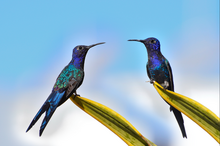 |
Change color depth

It is possible, using the software, to change thecolor depthof images. Common color depths are 2, 4, 16, 256, 65,536 and 16.7 million colors. The JPEG and PNG image formats are capable of storing 16.7 million colors (equal to 256 luminance values per color channel). In addition,grayscaleimages of 8bitsor less can be created, usually via conversion anddown-samplingfrom a full-color image.Grayscale conversionis useful for reducing the file size dramatically when the original photographic print was monochrome, but a color tint has been introduced due to aging effects.
Contrast change and brightening
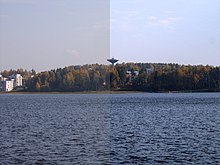
Image editors have provisions to simultaneously change thecontrast of imagesand brighten or darken the image.Underexposed imagescan often be improved by using this feature. Recent advances have allowed more intelligent exposure correction whereby only pixels below a particularluminositythreshold are brightened, thereby brightening underexposed shadows without affecting the rest of the image.
The exact transformation that is applied to each color channel can vary from editor to editor.GIMPapplies the following formula:[11]
if(brightness<0.0)value=value*(1.0+brightness);
elsevalue=value+((1-value)*brightness);
value=(value-0.5)*(tan((contrast+1)*PI/4))+0.5;
wherevalueis the input color value in the 0..1 range andbrightnessandcontrastare in the −1..1 range.
Gamma correction
In addition to the capability of changing the images' brightness and/or contrast in a non-linear fashion, most current image editors provide an opportunity to manipulate the images'gamma value.
Gamma correction is particularly useful for bringing details that would be hard to see on most computer monitors out of shadows. In some image editing software, this is called "curves", usually, a tool found in the color menu, and no reference to "gamma" is used anywhere in the program or the program documentation. Strictly speaking, the curves tool usually does more than simple gamma correction, since one can construct complex curves with multipleinflection points,but when no dedicated gamma correction tool is provided, it can achieve the same effect.
Color adjustments

The color of images can be altered in a variety of ways. Colors can be faded in and out, and tones can be changed usingcurvesor other tools. The color balance can be improved, which is important if the picture was shot indoors with daylight film, or shot on a camera with thewhite balanceincorrectly set. Special effects, likesepia toneand grayscale, can be added to an image. In addition, more complicated procedures, such as the mi xing of color channels, are possible using more advanced graphics editors.
Thered-eye effect,which occurs when flash photos are taken when the pupil is too widely open (so that light from the flash that passes into the eye through the pupil reflects off the fundus at the back of the eyeball), can also be eliminated at this stage.
Dynamic blending

Advanced Dynamic Blending is a concept introduced by photographerElia Locardiin his blogBlame The Monkeyto describe the photographic process of capturing multiple bracketed exposures of a land or cityscape over a specific span of time in a changing natural or artificial lighting environment. Once captured, the exposure brackets are manually blended together into a single High Dynamic Range image using post-processing software. Dynamic Blending images serve to display a consolidated moment. This means that while the final image may be a blend of a span of time, it visually appears to represent a single instant.[12][13][14]
Printing

Controlling the print size and quality of digital images requires an understanding of thepixels-per-inch(ppi) variable that is stored in the image file and sometimes used to control the size of the printed image. WithinAdobe Photoshop's Image Size dialog, the image editor allows the user to manipulate both pixel dimensions and the size of the image on the printed document. These parameters work together to produce a printed image of the desired size and quality. Pixels per inch of the image, pixel per inch of the computer monitor, and dots per inch on the printed document are related, but in use are very different. The Image Size dialog can be used as an image calculator of sorts. For example, a 1600 × 1200 image with a resolution of 200 ppi will produce a printed image of 8 × 6 inches. The same image with 400 ppi will produce a printed image of 4 × 3 inches. Change the resolution to 800 ppi, and the same image now prints out at 2 × 1.5 inches. All three printed images contain the same data (1600 × 1200 pixels), but the pixels are closer together on the smaller prints, so the smaller images will potentially look sharp when the larger ones do not. The quality of the image will also depend on the capability of the printer.
Warping
This section is empty.You can help byadding to it.(November 2018) |
See also
- Color space
- Comparison of raster graphics editors
- Computer graphics
- Digital darkroom
- Digital image processing
- Digital painting
- Dynamic imaging
- Digital photograph restoration
- Graphic art software
- Graphics file format summary
- Homomorphic filtering
- Image development (visual arts)
- Image distortion
- Image processing
- Image retrieval
- Image warping
- Inpainting
- Photograph manipulation
References
This article includes a list of generalreferences,butit lacks sufficient correspondinginline citations.(March 2011) |
- ^Johnson, Justin; Alahi, Alexandre; Fei-Fei, Li (2016-03-26). "Perceptual Losses for Real-Time Style Transfer and Super-Resolution".arXiv:1603.08155[cs.CV].
- ^Grant-Jacob, James A; Mackay, Benita S; Baker, James A G; Xie, Yunhui; Heath, Daniel J; Loxham, Matthew; Eason, Robert W; Mills, Ben (2019-06-18)."A neural lens for super-resolution biological imaging".Journal of Physics Communications.3(6): 065004.Bibcode:2019JPhCo...3f5004G.doi:10.1088/2399-6528/ab267d.ISSN2399-6528.
- ^Blau, Yochai; Michaeli, Tomer (2018).The perception-distortion tradeoff.IEEE Conference on Computer Vision and Pattern Recognition. pp. 6228–6237.arXiv:1711.06077.doi:10.1109/CVPR.2018.00652.
- ^Zeeberg, Amos (2023-08-23)."The AI Tools Making Images Look Better".Quanta Magazine.Retrieved2023-08-28.
- ^Cohen, Joseph Paul; Luck, Margaux; Honari, Sina (2018)."Distribution Matching Losses Can Hallucinate Features in Medical Image Translation".In Alejandro F. Frangi; Julia A. Schnabel; Christos Davatzikos; Carlos Alberola-López; Gabor Fichtinger (eds.).Medical Image Computing and Computer Assisted Intervention – MICCAI 2018.21st International Conference, Granada, Spain, September 16–20, 2018, Proceedings, Part I. Lecture Notes in Computer Science. Vol. 11070. pp. 529–536.arXiv:1805.08841.doi:10.1007/978-3-030-00928-1_60.ISBN978-3-030-00927-4.S2CID43919703.Retrieved1 May2022.
- ^Detailed introduction tohistogramsArchived2017-03-17 at theWayback Machineand thelevelsArchived2017-03-18 at theWayback MachineandcurvesArchived2017-03-17 at theWayback Machinefunctionality available in most image editing software; PhotoshopEssentials
- ^Implementations includeImagic PhotoArchived2013-01-03 atarchive.today,ViesusArchived2022-02-09 at theWayback Machine,andTopazArchived2018-05-13 at theWayback Machine
- ^Implementations includeFocusMagicArchived2008-05-09 at theWayback Machine,andPhotoshopArchived2008-06-03 at theWayback Machine
- ^JPFix."Skin Improvement Technology".Archivedfrom the original on 2016-03-05.Retrieved2008-08-23.
- ^Guyer, Jeff (24 September 2013)."The Sabattier Effect".Digital Photography School.Archivedfrom the original on 2019-01-09.Retrieved2019-01-09.
- ^GIMP source code for brightness and contrast image filtering.
- ^Lazzell, Jeff."A Dynamic Blending and Post Processing Workshop With Travel Photographer Elia Locardi".blog.xritephoto.Archivedfrom the original on September 11, 2016.RetrievedSep 11,2016.
- ^Cedric, De Boom."Blending moments in time".cedricdeboom.github.io.Archivedfrom the original on October 8, 2016.RetrievedSep 11,2016.
- ^"HDR photography with Elia Locardi".cnet.Archivedfrom the original on September 22, 2016.RetrievedSep 11,2016.
- "Fantasy, fairy tale and myth collide in images: By digitally altering photos of landscapes, artist Anthony Goicolea creates an intriguing world", The Vancouver Sun (British Columbia); June 19, 2006.
- "It's hard to tell where pixels end and reality begins", The San Francisco Chronicle; September 26, 2006.
- "Virtual Art: From Illusion to Immersion", MIT Press 2002; Cambridge, Massachusetts
